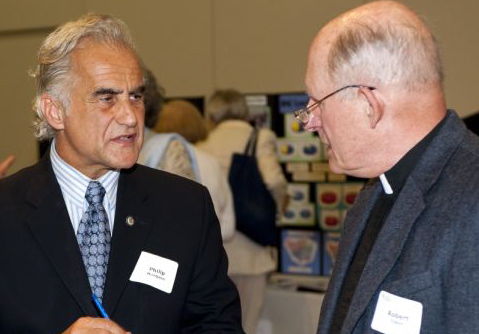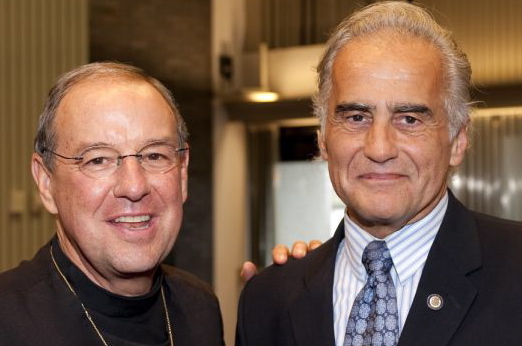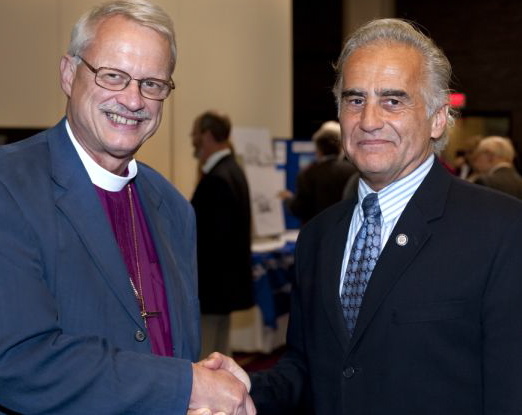This issue of The American Round Table is coming to you to make our partners aware of new initiatives to prevent and end homelessness. Enter a subscription now for yourself or a colleague so you don't miss a single issue or announcement. Click here to join our distribution list for The Round Table and related announcements.
| |
|
|
 IN WASHINGTON:
THE AMERICAN ROUND TABLE TO ABOLISH HOMELESSNESS CONVENES PARTNERS FROM 21
CITIES, COUNTIES, AND STATES TO FOCUS ON
"WHAT'S WORKING" IN PARTNERSHIP, INNOVATION, AND RESULTS IN WASHINGTON:
THE AMERICAN ROUND TABLE TO ABOLISH HOMELESSNESS CONVENES PARTNERS FROM 21
CITIES, COUNTIES, AND STATES TO FOCUS ON
"WHAT'S WORKING" IN PARTNERSHIP, INNOVATION, AND RESULTS
WASHINGTON, DC.
Meeting in Washington's historic New York Avenue Presbyterian Church, where
President Lincoln worshipped and which houses the precursor to the Emancipation
Proclamation in Lincoln's own hand, and in which Dr. Martin Luther King
preached to end another social wrong, The American Round Table To Abolish Homelessness
last week welcomed partners from 21 cities, counties, and states, and the
District of Columbia. Convened in the great tradition of ending social wrong in
that place, the invited partners focused on the "good news" of "what's working"
in cities and states.
The Round Table's President, Philip Mangano, welcomed
partners to the Radcliffe Room, noting the historic site of the church just two
blocks from the White House and its role in earlier abolitionism. He discussed
with partners the new opportunity of the new Administration and new federal
capital investments in rapid rehousing and prevention, as well as ongoing
developments in the next federal budget. He emphasized the need to focus on
housing solutions for homeless veterans in jurisdictional plans and strategies.
"The Round Table is intended to convene partners to abolish
the wrong of homelessness. Disseminating innovation, supporting jurisdictional
leadership, and inspiring an abolitionist intent are the core of The Round
Table's mission," indicated Mr. Mangano.
Mr. Mangano stressed the opportunity for recalibration of
Ten Year Plan while lessons are learned from new federal investments, as well
as the importance of continuing and expanding focus on housing, employment, veterans, and
effective engagement, including through Project Homeless Connect. Partners
offered their own examples of "what works" in faith community innovations,
business partnership, and new data.
The Radcliffe Room welcomes homeless neighbors for its
Sunday coffee hour hosted by church deacons, as it has for decades. From Lincoln's
pew in the sanctuary, to his draft copy of the Emancipation Proclamation in the
Lincoln Parlor, to the upholstered bench where he attended Bible study, the
church has preserved President Lincoln's participation in the congregation of
its day. Then Reverend Phineas Gurley, with whom President Lincoln consulted on
the Emancipation Proclamation, presided over Lincoln's White House funeral and
accompanied the President's funeral train to Springfield,
Illinois.
Mr. Mangano also noted the passing of Reverend William
"Father Bill" McCarthy (see related story), whose commitment to his poorest
neighbors and early adoption of housing solutions were exemplary.
|
DALLAS, TEXAS IS LATEST JURISDICTION TO
UNVEIL COST ANALYSIS OF "RANDOM RICOCHETING" OF CHRONICALLY HOMELESS AND OTHER
POPULATIONS
DALLAS, TEXAS. "Somebody
would be fired in the business world if they got those results," City of
Dallas Ten Year Plan Community Champion Mike Rawlings told the Dallas Morning
News, commenting on the estimated $50 million being spent annually to shuffle
and cycle the city's most vulnerable street and chronic population. "What
do we get? They're still homeless," he stated.
The estimate
includes figures for perhaps 600 to 1,000 of the most complex individuals who
routinely "randomly ricochet" among emergency rooms, psychiatric hospitals,
jails, and ambulance rides. While some local facilities, such as Parkland Memorial Hospital, track the use
by the homeless population - reported at about $15.6 million in 2008, - other providers of treatment and services can only estimate what the status quo
is costing. ValueOptions, the national for-profit behavioral health care
company serving the region, estimated that three individuals consumed $183,000
in psychiatric and substance abuse treatment over 169 days in 2008-2009.
Other
contributors to the estimate included
Lew Sterrett Justice Center (County jail); Dallas Fire-Rescue ambulance
services; Dallas County Courts; Dallas Metrocare Services (mental health care);
Terrell State Hospital (psychiatric hospitalization); Dallas Police Department;
LifeNet mental health care; Dallas School District for homeless student
services; Dallas County Health and Human Services for temporary shelter; City
of Dallas Crisis Intervention outreach and assistance; and Texas Department of
Transportation for cleanup of camps along freeways. The use of programs funded
by the U.S. Departments of Housing and Urban Development and Veterans Affairs
was also included in the estimate.
"Dallas has now joined more
than 70 jurisdictions across the United States and Canada that have created cost
studies and cost benefit analyses that clearly indicate that the cost of random
ricocheting is more expensive than investments in housing solutions," indicated
Philip Mangano. "In the 7 years of the work of the Interagency Council, we
encouraged such studies which have generated an unprecedented political will to
move beyond maintaining past efforts to solving the problem."
Use of the
city's one-year-old "Bridge" center was also included. In just one year, The Bridge surpassed
its goals to engage and support individuals in moving out of chronic
homelessness to housing and employment. Dallas and its county partners are one
of many jurisdictional partnerships that have engaged the results of cost
benefit analysis in making investment and resources decisions. A 2007 study
year showed that nearly 10% of the Dallas County Jail population was
characterized by both homeless and frequent use of the jail, prompting the
county to invest in the new center, along with the city.
At the one-year
anniversary event for the center in June 2009, Mr. Rawlings noted that the
initial results showed that the $21 million voter-approved center was paying
off. Dallas partners reported
permanent residences for 414 people, exceeding the goal of 300, and jobs for
780 individuals, as well as a new public/private funding coalition that was
created. City of Dallas Mayor Tom Leppert and Mike Faenza,
President and CEO of the Metro Dallas Homeless Alliance, which runs the center,
noted the progress.
Mayor Leppert
was one of the mayors of the largest cities in Texas who joined their local
Ten Year Plan strategies to seek new investment in the state budget this year for mental
health services for people who are homeless and new initiatives to achieve
successful prisoner reentry. Fort Worth Mayor Moncrief, San Antonio Mayor Phil
Hardberger, and Houston Mayor Bill White also took part.
The recent 4th
Annual Homeless Assessment Report (AHAR) reported a 43% decrease in the
unsheltered population in Dallas from 2006 to 2008.
Data reported to HUD on the number of chronically homeless persons showed a
decrease from 1,001 in 2005 to 620 in 2008.
In 2007 Mr.
Rawlings was recognized with the 2007 Community Champion "A Home for Every
American" Award at the U.S. Interagency Council on Homelessness' Second Annual National Summit on Innovation
for Jurisdictional Leaders.
|
THE
CENTRAL ANTIDOTE OF HOUSING IS FOCUS OF HUD SECRETARY DONOVAN AS HE HIGHLIGHTS
IMPACT OF COST ANALYSIS IN REMARKS TO NATIONAL HOMELESSNESS CONFERENCE
WASHINGTON, DC. "We showed them," said
U.S. Department of Housing and Urban Development Secretary and U.S. Interagency
Council on Homelessness Chair Shaun Donovan, as he addressed the National
Alliance to End Homeless Conference last week in the nation's capital. "By
developing the 'technology' of combining housing and supportive services - delivering
permanent supportive housing via a targeted pipeline of resources - we've
'moved the needle' on chronic homelessness, reducing the number of chronically
ill, long-term homeless by nearly a third in the three years since 'Million
Dollar Murray' was published."
"Million Dollar Murray," a
landmark article subtitled "Why problems like homelessness may be easier to
solve than to manage," and published in The New Yorker, was authored by
noted business thinker Malcolm Gladwell. In 2006 Gladwell's research from across the
country was inspired by the U.S. Interagency Council on Homelessness and, as a result of a national itinerary set by the Council, spotlighted several of the local cost analysis studies just beginning
to emerge as a Council strategy through the innovation of jurisdictional Ten
Year Plans. "Tipping Point" author Gladwell, who addressed the 2004 inaugural "Innovators' Summit" of Mayors, County Executives, and State
point people co-convened by the Council and Common Ground, and supported by The
Rockefeller Foundation, reported on cost research from the preeminent case
of San Diego, from Philadelphia, Denver, and Boston.
"Secretary
Donovan's comment on the reversal of the seeming intractability of street
homelessness underscores the success of the strategy of the last seven years of
business planning, cost analysis, and relentless focus on 'what works' that has
driven unprecedented partnership, planning, investment, and results in our
country," indicated former U.S. Interagency Council on Homelessness Executive
Director and The American Round Table President Philip Mangano. "The single most important factor in reducing
street homelessness in those cities was the determined and unflinching
political will of the jurisdictional CEO. When mayors in major
metropolitan centers partnered in the creation of strategic plans informed by
business and economic principles and practices and extended their political
will to reduce and end street homelessness, results were achieved."
Added Mr. Mangano, "We had long hoped that
moral, spiritual, and humanitarian arguments would drive political will to
remedy the problem. Not in one place has that happened. The economic data has
stimulated unprecedented political will to solve the problem as a cost
effective strategy."
Secretary Donovan went on
to say, "It turns out, furthermore, that this group costs the health-care and
social services systems far more than anyone had ever anticipated," he noted,
quoting the research of Dr. Dennis Culhane of the University of Philadelphia in the development of the
typology of individuals which led to the identification of the "chronic"
population of long-stayers with disabilities.
Noted Secretary Donovan:
"What was missing was leadership - leadership that recognized when we harness
public resources and the enormous wellspring of human capital in this country
we can provide everyone - from the most capable to the most vulnerable - the
opportunity to reach their full potential." Secretary Donovan commended HUD and
Council staff and said his tenure will emphasize interagency partnership, use
of HUD's recovery and mainstream resources and programs along with the new
Housing Trust Fund, and the potential for the federal health care reform effort
to benefit people experiencing homelessness.
"We all hope Secretary
Donovan and the new Administration will advance the important work already
accomplished to reduce street and chronic homelessness in our country as well
as advancing deeper partnership with federal agencies, especially HHS,"
indicated Philip Mangano.
|
 REMEMBERING "THE PEOPLE'S
PRIEST" WHOSE GOAL WAS TO CLOSE THE SHELTER DOORS REMEMBERING "THE PEOPLE'S
PRIEST" WHOSE GOAL WAS TO CLOSE THE SHELTER DOORS
QUINCY, MASSACHUSETTS. As friends, supporters, and
homeless and formerly homeless people gathered last week in Massachusetts to
mark the passing of 82-year-old Reverend William "Father Bill" McCarthy, the
namesake of Father Bill's Place in Quincy, Massachusetts, the stories of "The
People's Priest" were numerous. His pride in the shelter that bore his name for
more than 20 years and welcomed many in all kinds of difficulty to its simple
site, the compassionate heart that buttonholed many a donor and legislator with
savvy, the missing linens and furniture that he had given someone in need
(along with the warm coat off his back), and - perhaps more than anything - his
resolve to create housing and "take the sign down" that carried his name as a
sign of ending homelessness.
"Father Bill was everybody's priest,"
indicated Philip Mangano. "He began his ministry to our homeless neighbors with
our best efforts of church shelters and soup kitchens and evolved into a
determined advocate for new resources for housing at the Massachusetts State
House. In many ways Father Bill personified the mind-set shift in this country
during this decade. A shift from merely servicing homeless people to solving
their homelessness."
John Yazwinski, current CEO
of Father Bill's & Main Spring, which represents a merger of Quincy and Brockton programs and resources, put his
thoughts to Father Bill directly: "To all of us, you have been a great leader,
a great priest, and a great friend. My promise to you is that we will work hard
every day to realize your dream of 'taking the sign down' at Father Bill's
Place; because nobody should be homeless."
As Father Bill celebrated his 80th
birthday in 2007, the City of Quincy joined in, recognizing the key
developments that were influencing the success of the Quincy 10-Year Plan to End
Chronic Homelessness. Shown here at center at a Father Bill's ribbon-cutting are Mr. Mangano (at front left) and Father Bill (at rfront ight). At rear is Joe Finn, previously Executive Director of Father Bill's, now Executive Director of the Massachusetts Housing and Shelter Alliance and a Quincy City Council Member. In front of Mr. Finn is Quincy City Council President Jay Davis, and a representative of Keyspan Energy.
The Claremont SRO Project,
dedicated in 2006, was Father Bill's first initiative to implement the Housing
First model and provide permanent supportive housing for 12 chronically
homeless women. In May 2006, community
Ten Year Plan partners cut the ribbon for Father
McCarthy's House, providing permanent supportive housing for 19 chronically
homeless veterans. For over a decade, Father Bill's had moved toward the
solution of housing, adding over 150 permanent and transitional units to its
140 shelter beds.
|
 PHILIP
MANGANO RECEIVES TOBIN SOCIAL JUSTICE AWARD FROM EPISCOPAL DIOCESE OF
MASSACHUSETTS AS HE CALLS FOR ACTION AND REFLECTION TO END HOMELESSNESS PHILIP
MANGANO RECEIVES TOBIN SOCIAL JUSTICE AWARD FROM EPISCOPAL DIOCESE OF
MASSACHUSETTS AS HE CALLS FOR ACTION AND REFLECTION TO END HOMELESSNESS
BOSTON, MASSACHUSETTS. Philip Mangano was
presented the Rev. Robert Tobin Award at the Annual Meeting of the Episcopal
City Mission (ECM) of the Diocese of Massachusetts. "I could not be more
honored to receive anything that has Bob's name on it," indicated Mr. Mangano.
"In my days as Director of Homeless Services for the City of Cambridge, and in the work of the
Cambridge Clergy for Affordable Housing, I had the great privilege to work with
Bob, receiving his counsel often, watching his capacity to speak the truth to
power fearlessly. He inspired my work against injustice, moving forward no
matter what the cost might be in people misunderstanding him or not liking him.
To 'speak the truth to power' is oft referenced, but less often practiced." Mr.
Mangano is shown here with Rev. Tobin.
 Speaking at the Annual Meeting at Boston University, Mr. Mangano praised
the work of the 155-year-old partnership with the parishes in the Diocese of
Massachusetts, community organizers, and the people of local communities: "Alone
neither action nor reflection will overcome the inexhaustible need of those
suffering the long miseries of homelessness and poverty," he stated. Mr.
Mangano is shown here with The Rt. Rev. M. Thomas Shaw, SSJE, Diocesan
Bishop. Speaking at the Annual Meeting at Boston University, Mr. Mangano praised
the work of the 155-year-old partnership with the parishes in the Diocese of
Massachusetts, community organizers, and the people of local communities: "Alone
neither action nor reflection will overcome the inexhaustible need of those
suffering the long miseries of homelessness and poverty," he stated. Mr.
Mangano is shown here with The Rt. Rev. M. Thomas Shaw, SSJE, Diocesan
Bishop.  "Action
without reflection becomes charity that enables the status quo of the recipient,
our good intentions, and government systems. Reflection without action make us
policy pollyannas content to worship our rhetoric," Mr. Mangano said. Also present for the ceremonies were The Rt. Rev. Gayle E.
Harris, Suffragan Bishop, and retired Bishop Barbara Harris, with ECM Executive Director Ruy Costa and ECM Chair Bill
Haynsworth. "Action
without reflection becomes charity that enables the status quo of the recipient,
our good intentions, and government systems. Reflection without action make us
policy pollyannas content to worship our rhetoric," Mr. Mangano said. Also present for the ceremonies were The Rt. Rev. Gayle E.
Harris, Suffragan Bishop, and retired Bishop Barbara Harris, with ECM Executive Director Ruy Costa and ECM Chair Bill
Haynsworth.
 ECM
has invested significant resources in addressing housing and homelessness
issues, including through grants to parishes seeking to develop housing for the neediest in their communities, grants to community organizers promoting housing, and the expansion of a network of parishes and people
working to end family homelessness in the commonwealth. Mr. Mangano is shown
here with The Rt.
Rev. Roy F. "Bud" Cederholm, Bishop Suffragan. ECM
has invested significant resources in addressing housing and homelessness
issues, including through grants to parishes seeking to develop housing for the neediest in their communities, grants to community organizers promoting housing, and the expansion of a network of parishes and people
working to end family homelessness in the commonwealth. Mr. Mangano is shown
here with The Rt.
Rev. Roy F. "Bud" Cederholm, Bishop Suffragan.
Coming soon on the web site of The American Round Table will be the Episcopal City Mission remarks of Philip Mangano, as well as other speeches and presentations, and copies of the past e-news issues.
|
You are receiving this issue of The American Round Table as we make our partners aware of new initiatives to prevent and end homelessness. To subscribe yourself or a colleague for future issues, click here to join our mailing list.
To learn more about The American Round Table, contact
quest@abolitionistroundtable.com
| |
|